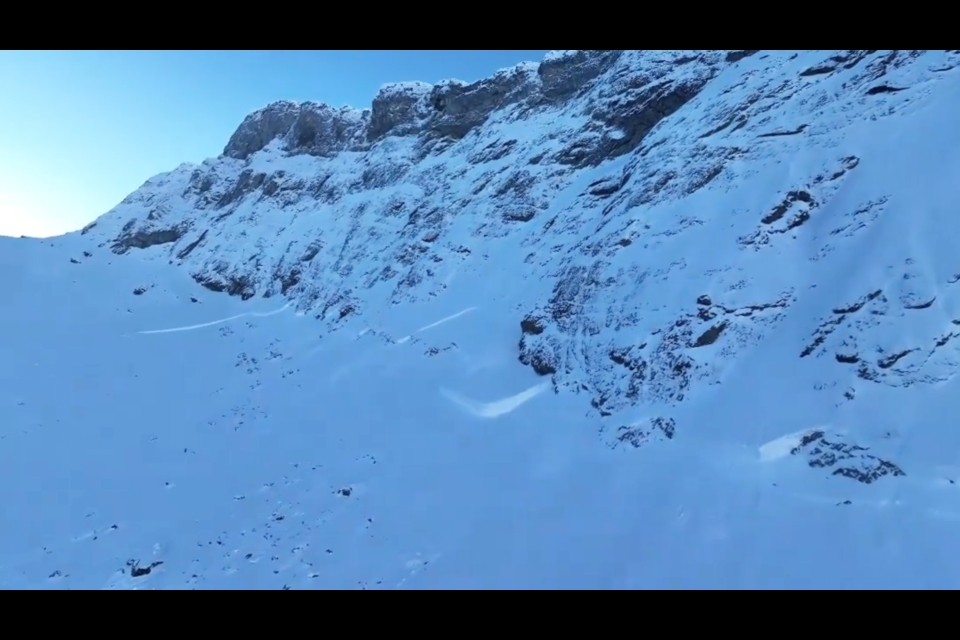KANANASKIS COUNTRY – Avalanche experts are describing last week’s cycle in Kananaskis Country as one of the largest and most widespread in the region in two decades.
A combination of warming temperatures and recent snowfall, paired with a season-long deep persistent slab problem, led to several avalanches recorded throughout the region up to size 3.5
“This was a really large, significant avalanche cycle that took out almost all main features along the Spray [Lakes] Road,” said Darren Vonk, a rescue specialist with Kananaskis Mountain Rescue.
“For one of our colleagues that’s been here for over 20 years, he said it’s one of the biggest avalanche cycles he’s seen on the Spray around this time.”
A storm that carried about 20 cm of new snow over April 11-12 was the “tipping point” to a shaky snowpack in the region, said Vonk.
“This snowpack is sitting on a very weak base, which we’ve been reporting all season long is just not giving us any confidence in terms of travelling in big terrain. Last week’s storm added a bunch of new load to this already precarious snowpack,” he said.
The Kananaskis rescue program performs avalanche control and forecasting in the region. In one of their main control areas at Mount Buller, a size three avalanche that occurred around April 12, ran within 50 to 100 metres of Spray Lakes Road.
“There was debris stacking up 10-15 feet high, stopped just off the highway,” said Vonk.
Many of the slides that did occur started in the alpine area where snow was dry and then ran down into warmer, rain-saturated snow creating larger avalanches.
Of the avalanches the Kananaskis rescue program observed, including the one on Mount Buller, all were natural and not human-triggered.
“The tipping point was reached in the snowpack and everything that did come down, came down naturally,” said Vonk.
Fortunately, it seems mountain-goers have been paying attention to the information the rescue and avalanche program has been putting out about conditions as there have been no related rescues required.
“We’ve been very blunt with our messaging starting in the fall, and it seems to be adhered to and respected by most people that have really toned down what they’re doing this winter,” Vonk said.
“It’s just too risky with that base of the snowpack ready to go at any time. The little bit of skiing we've been doing as forecasters this year has been choosing safe, low-angle terrain – not exposing ourselves to any overhead hazards or any potential avalanche terrain because it’s just not worth it.”
West of the Alberta border, on Saturday (April 15), a snowmobiler in a party of three died in an avalanche triggered at Thunderwater Lake riding area near Invermere, B.C., according to an Avalanche Canada report. The slide was reported to be a size three.
Since January, 14 avalanche fatalities have been recorded in B.C. following the most recent death.
The deep persistent slab in the snowpack is not unusual for Kananaskis and Banff National Park, but experts say it is a one-in-10-year problem in the interior and coastal mountain ranges of British Columbia, and that it is worse than usual on the east side of the Rockies.
“This year’s avalanche season is plagued by a deeply buried weak layer across much of western Canada, making it one of the most difficult snowpacks to safely manage in decades,” reads a March 2 report by Avalanche Canada forecaster Mike Conlan.
“The layer of concern formed in November and is buried near the base of the snowpack, which means it varies from over [one metre] deep in the Rockies to over [three metres] deep in the Columbia and Coast Mountains. This weak layer has caused many high-consequence avalanches since its formation and has already claimed numerous lives.”
As temperatures rise, Vonk said Kananaskis Mountain Rescue is changing its public safety messaging focused on avalanches concerning a dry winter snowpack, to the destabilizing effects of spring.
“We’re now getting to the point where we’re going to see daily melting and freezing of the snowpack, and the warmer weather we have, the further that melt is going to go,” he said.
“Now is the time of year where you need to start your day in the mountains very early and leave very early, so the sun doesn’t have a chance to warm up and destabilize that snowpack to a point where it slides.”
As of Wednesday (April 19), the risk of avalanche in the Kananaskis region was rated as moderate at treeline and considerable at alpine levels, according to Avalanche Canada. In Banff, Yoho and Kootenay national parks, the risk was considerable at or above treeline.
The Local Journalism Initiative is funded by the Government of Canada. The position covers Îyârhe (Stoney) Nakoda First Nation and Kananaskis Country.




